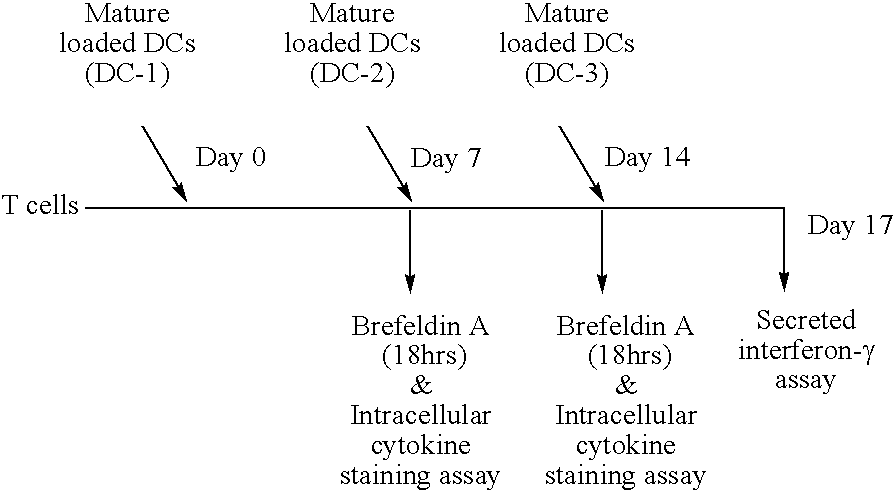Chimeric antigens for breaking host tolerance to foreign antigens
a technology of foreign antigens and chimeric antigens, which is applied in the direction of blood/immune system cells, peptides, drug compositions, etc., can solve the problems of inability of the immune system to prevent the resultant disease, lack of proper presentation of foreign antigens, and ineffective prophylactic or therapeutic vaccines
- Summary
- Abstract
- Description
- Claims
- Application Information
AI Technical Summary
Benefits of technology
Problems solved by technology
Method used
Image
Examples
example 1
A. Example 1
[0146] Construction of TBD Expression Vector
[0147] Mouse IgG1 DNA sequences encoding amino acids of a portion of C.sub.H1-Hinge-C.sub.H2-C.sub.H3 region was generated from mRNA isolated from the hybridoma (2C12), which produces mAb against HBV surface antigen (sAg). Total mRNA was isolated using Trizol.RTM. reagent (Gibco BRL cat. No. 15596-026) and the cDNA of the target binding domain (TBD; mouse immunoglobulins fragment) was generated by RT-PCR using Superscript First-strand Synthesis (Invitrogen Cat. No. 11904-018). The PCR primers contained linker sequences encoding the linker peptide-SRPQGGGS-(SEQ ID NO: 1) at the 5' terminus, a unique Not I site at the 5' and a unique Hind III restriction site at the 3' end. The resulting cDNA contains (5' Not I )-linker sequence-C.sub.H1(VDKKI) (SEQ ID NO: 2). -Hinge Region-C.sub.H2-C.sub.H3-(3' Hind III). Following digestion with the respective enzymes, the fragment is ligated with pFastBac HTa expression vector plasmid (Invitro...
example 2
B. Example 2
[0152] Construction of Chimeric Antigen Expression Vectors
[0153] The DNA encoding the desired viral antigen was generated from the template using PCR methodology using the 5' sense and 3' anti-sense primers indicated in Table 2. The 5' end of the resulting amplified fragment contained the unique restriction site "5' enzy," and the 3' end contained the unique restriction site "3' enzy," each of which was used for ligations.
2TABLE 2 Construction of Chimeric Antigen Vectors Anti-sense Viral antigen Sense primer primer Template 5' enzy 3' enzy HBV S1 / S2 SEQ ID NO: 7 SEQ ID NO: 8 pRSETB HBV S1 / S2 Bam HI Not I HBV S1 / S2 / S SEQ ID NO: 9 SEQ ID NO: 10 pAlt HBV 991 Nco I Not I HBV Core SEQ ID NO: 11 SEQ ID NO: 12 pAlt HBV 991 Nco I Not I DHBV PreS / S SEQ ID NO: 5 SEQ ID NO: 13 pFastBac Hta PreS / S Eco RI Not I DHBV PreS SEQ ID NO: 5 SEQ ID NO: 14 pFastBac HTa PreS / S Eco RI Not I DHBV Core SEQ ID NO: 15 SEQ ID NO: 16 pRSETB DHBV Core Nco I Not I HCV Core (1-191) SEQ ID NO: 17 SEQ ID ...
example 3
C. Example 3
[0155] Expression and Purification of TBD, Viral Antigens and Chimeric Antigens
[0156] Recombinant bacmids of standardized multiplicity of infection (MOI) were used to infect High Five.TM. insect cells. For suspension cultures, cells were seeded at a density of 3.times.10.sup.5 cells / mL and incubated at 27.5.degree. C. with shaking at 138 rpm until the cell density reached 2-3.times.10.sup.6 cells / mL. Standardized amounts of the respective recombinant baculovirus was added to the cells. The incubation temperature was 27.5.degree. C. and the appropriate infection period was standardized for individual protein expression. The cells were harvested by centrifugation at 2,500 rpm for 10 minutes at 4.degree. C. and used for the purification of the recombinant proteins. Unused portions of cells were snap frozen in liquid nitrogen and stored at -70.degree. C.
[0157] Recombinant proteins were purified under denaturing conditions. The cells were lysed in a buffer containing 6 M Guan...
PUM
| Property | Measurement | Unit |
|---|---|---|
| temperatures | aaaaa | aaaaa |
| pH | aaaaa | aaaaa |
| temperature | aaaaa | aaaaa |
Abstract
Description
Claims
Application Information
 Login to View More
Login to View More - R&D
- Intellectual Property
- Life Sciences
- Materials
- Tech Scout
- Unparalleled Data Quality
- Higher Quality Content
- 60% Fewer Hallucinations
Browse by: Latest US Patents, China's latest patents, Technical Efficacy Thesaurus, Application Domain, Technology Topic, Popular Technical Reports.
© 2025 PatSnap. All rights reserved.Legal|Privacy policy|Modern Slavery Act Transparency Statement|Sitemap|About US| Contact US: help@patsnap.com



